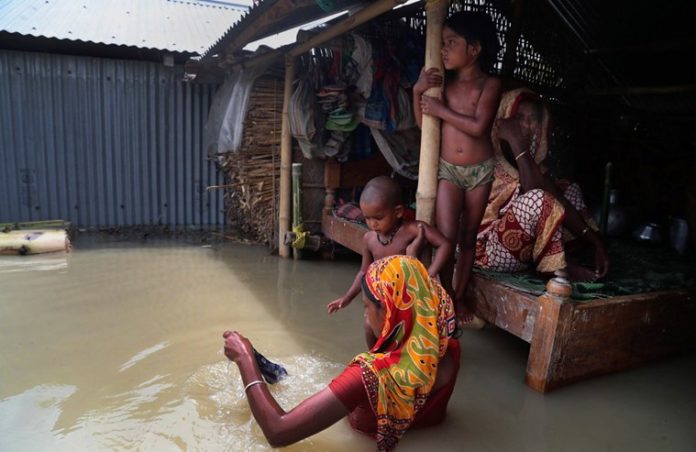New Delhi (NVI): Out of the total 4 million children that currently estimated to be affected by devastating flooding in South Asia, 2.4 million are from India alone, with many more at risk as COVID-19 brings further challenges, the UNICEF said in a report today.
According to the UN body, weeks of torrential monsoon rains, widespread flooding and deadly landslides in Bangladesh, India and Nepal have affected millions of children and families. As a result, over 4 million children are currently estimated to be impacted and in urgent need of life-saving support, with many millions more at risk.
“Even for a region that is all-too-familiar with the devastating impact of extreme weather, the recent heavy monsoon rains, rising floods and continued landslides are creating a perfect storm for children and families affected,” said Jean Gough, UNICEF Regional Director for South Asia.
“The COVID-19 pandemic and containment and prevention measures add an additional complication to the mix, as COVID-19 cases are accelerating in some of the affected areas,” she added.
Over 700 people have died and dozens are missing in across the four countries, with continuing reports of children drowning.
In India, over 6 million people across Bihar, Assam, Odisha, Gujarat, Maharashtra, Madhya Pradesh, Kerala, Uttarakhand, Uttar Pradesh and West Bengal have been affected by the floods, including an estimated 2.4 million children, says the UNICEF report.
Though flooding at this period of the year is common, this widespread scale of floods during mid-July is unusual. At the same time, India has seen the daily number of COVID-19 cases crossing the 30,000 thresholds, as per the report.
UNICEF said that it is working with the Government and partners to respond quickly and effectively. UNICEF is also supporting the Government of Assam to implement the COVID-19 adapted relief camp management guidelines and Child Friendly Spaces in select districts, in addition to its focused support for maternal and child health service continuity and COVID-19 response in many states.
In Bangladesh alone, more than 2.4 million people are estimated to be affected by flooding, including around 1.3 million children. More than half a million (548,816) families have lost their homes. The flooding has come at a time when Bangladesh is still recovering from Cyclone Amphan, and its already stretched emergency and health response systems are working hard to contain the spread of the COVID-19 virus. The country now has over 210,000 confirmed cases.
In Nepal, heavy monsoon rainfall has caused flooding and landslides across different parts of the country, impacting more than 20 districts, since 9 July. More than 100 people have died, 48 are missing and feared dead while 87 are injured. Over 10,000 people – half of them children – have been affected with an estimated 7,500 displaced from their homes. This same period has also seen a significant number of COVID-19 positive cases in Nepal.
In Bhutan, the monsoon rain has caused landslides across the country and is hampering transport and communication as the main highway and inter-district roads have been damaged. The flashfloods were caused by the overflow of the seven streams and tributaries to the Mao river. The water levels in the Mao remains very high posing significant risks for more flooding. The flooding has also caused damage to crops and a water treatment plant. So far four people have died because of the flooding.
UNICEF said that it is on the ground working in close coordination with respective governments and humanitarian partners to scale up its responses and support the immediate needs of affected children and their families, but the response is complicated by the COVID-19 pandemic and the associated containment and prevention efforts.
It said that measures such as physical distancing and handwashing need to be observed in order to minimize the risk of infections among affected populations, especially those in emergency shelters.
Many areas remain inaccessible due to damage to roads, bridges, railways and airports. The most urgent needs for children are clean water, hygiene supplies to prevent the spread of disease, food supplies and safe places in evacuation centres for children to play.
“The fall-out from the COVID-19 pandemic is being compounded by climate change and extreme weather events and are arguably the biggest issues affecting children in South Asia right now,” said Jean Gough.
“Immediate support, more resources and innovative programmes are urgently needed to address the challenges that these threats represent to the region’s children,” she added.
-ARK








